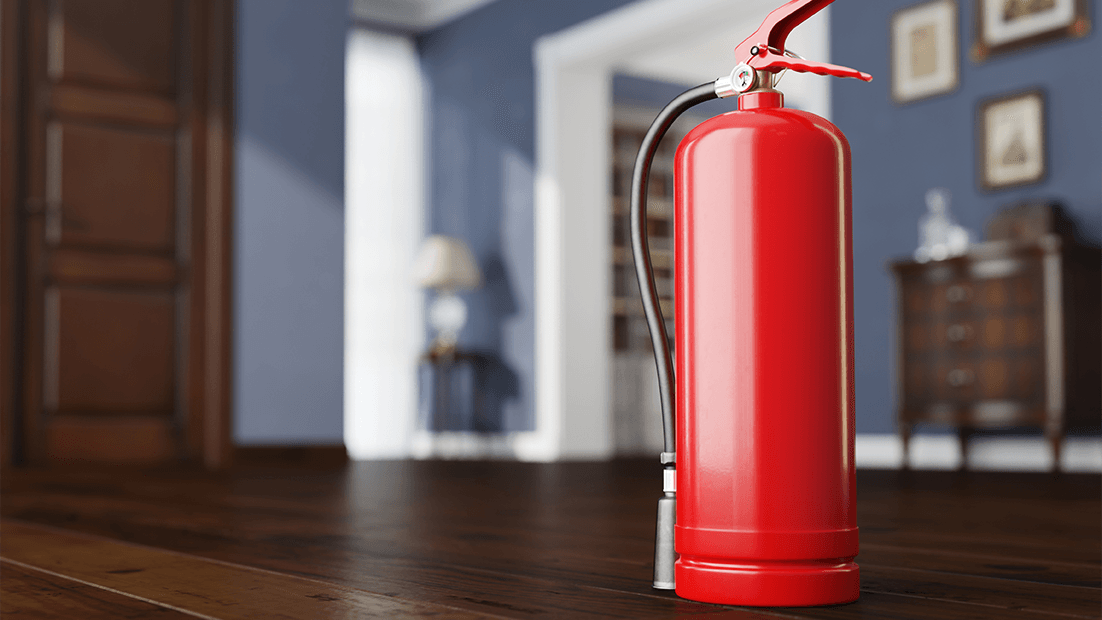Being prepared with a working fire extinguisher and the knowledge of how to use one properly could be the difference between a contained fire and an uncontrolled one. According to data provided by the National Fire Protection Association (NFPA), U.S. fire departments responded to around 346,600 house fires every year between 2015 and 2019. Chances are these fire safety tips will be useful to you over the course of your lifetime.
Fire Extinguisher Basics
A working fire extinguisher is a trusted fire safety measure. Remember, water can’t put out certain types of fires (including grease fires). In this instance, you’ll want a working extinguisher at the ready. Everyone in your household needs to know where the fire extinguishers are located, as well as how to use them properly.
Ensure You Have the Right Fire Extinguisher
If you’re buying a fire extinguisher for the first time, you’re going to want a multipurpose option large enough to handle a sizable fire, but manageable enough that you can handle it.
Here’s a breakdown of the different types of extinguishers available in today’s market:
-
- Class A – Handles solid combustibles like wood, cloth or paper products
- Class B – Flammable liquids and gasses
- Class C – Used for electrical fires
- Class D – Flammable metals
- Class K – Oil or grease fires
If you already own a fire extinguisher, check the expiration date. If it’s passed, it won’t be much use to you. Always be diligent about having a working extinguisher at the ready.
When you’re purchasing a workplace or home fire extinguisher, look at an ABC extinguisher. For about $60 you can get one from your local hardware store.
Of course, once you have your new fire extinguisher(s), don’t forget to read the instructions. In a fire safety emergency, you’ll be glad you know what you’re doing.
Store Your Fire Extinguishers Properly
Fire extinguishers should be located on every floor of your home, preferably near an exit. Because cooking remains the #1 cause of house fires, keep one nearby for kitchen safety. Remember, keep them away from children and never store them near something that heats up (such as a radiator, furnace, or fireplace).
Know When to Use Your Fire Extinguisher
When a fire is fairly contained, operate your fire extinguisher towards the fire, keeping your back towards an exit point in case you need to escape. If you see the room filling with smoke, or the fire spreading, leave immediately!
Before reaching for your fire extinguisher, ask yourself these questions:
– Who is taller: you or the fire? If the fire looms larger than you, evacuate the building, close off the room with fire, and immediately dial 911.
– What type of extinguisher do you have on hand? An ABC extinguisher can assist with very small grease fires, but might not be up to the task if it’s a larger fire.
– Is your extinguisher properly pressurized? Take a look at the gauge to make sure. If it’s not pressurized, it’s not going to be effective.
How to Use a Fire Extinguisher
Even if you’ve never used a fire extinguisher before, The National Fire Protection Association has a helpful acronym to help you remember what to do.
P-A-S-S
P – pull the pin. Point the nozzle away from you and release the pin.
A – aim the extinguisher low, right at the base of the fire.
S – squeeze the extinguisher lever slowly.
S – sweep from side-to-side.
Keep These Tips in Mind:
- When discharged, most extinguishers can reach 6-20 feet and last for 10-20 seconds.
- Once you see that the fire is out, you’re not in the clear quite yet. Survey the area to make sure that nothing else, such as a hotspot, reignites.
- MOST IMPORTANTLY: Once you’ve used your fire extinguisher, repressurize it or replace it right away! You don’t want to be unprepared for next time.
The Importance of Smoke Detectors
Being alerted to a fire is crucial to acting in time and preventing fire from spreading. Make sure you have regularly-tested, working smoke alarms on every floor of your room.
You also want to discuss a fire escape plan with your household. Check out the NFPA Fire Escape Plan for expert advice on escape planning. Create your own plan and practice it so everyone is prepared in the event of a fire safety emergency.
Restore Fire Damage with Paul Davis
Despite our best fire safety efforts, even the most prepared of us can experience the effects of extensive fire damage. Learn more about our unique fire restoration, including cleaning smoke residue, eliminating leftover odors, and drywall replacement. With over five decades of experience, Paul Davis of Greater MSP can transform your home after a fire so you and your family can return to normal.
If your home needs restoration following a fire, fill out our contact form for a quote.


